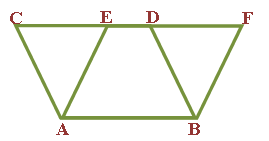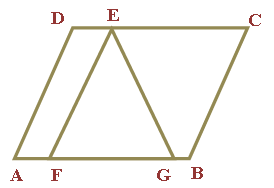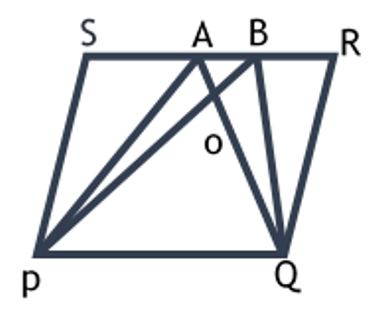Opposite Angles of a Parallelogram are Equal




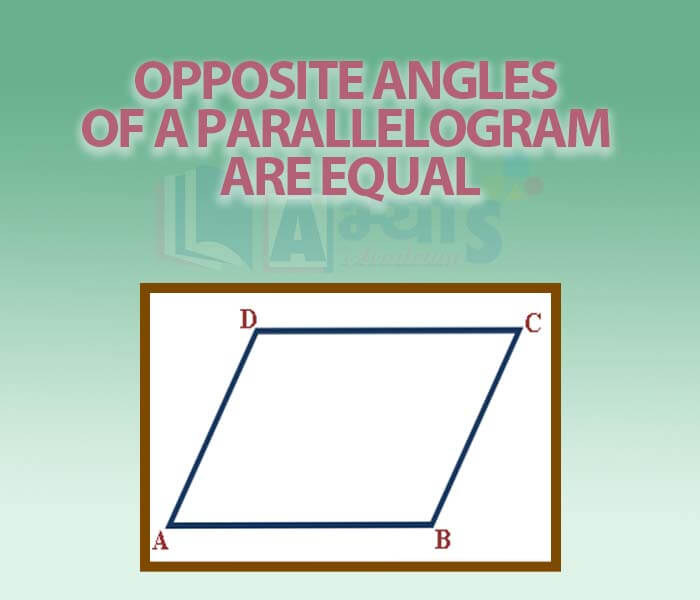
Opposite Angles of a Parallelogram are Equal
Theorem 3: The opposite angles of a parallelogram are equal. GIVEN A parallelogram ABCD To prove <A = <C and <B = <D Proof Since ABCD is a parallelogram. Therefore, AB Now, AB
Again, AD
From (i) and (ii), we get <A + <D = <D + <C
Similarly, <B = <D. Hence, <A = <C and <B = <D |  | |
| Converse Theorem: A quadrilateral is a parallelogram if its opposite angles are equal | ||
Given : A quadrilateral ABCD in which To Prove: ABCD is a Parallelogram. Proof: In a quadrilateral ABCD Adding (1) and (2)
Now Using equation (3) we get But As their sum is Again But As their sum is From (4) and (5) AD || BC and AB || CD Hence ABCD is a a parallelogram |  | |
Illustration: Find all the angles of the parallelogram ABCD the figure given. Solution: In triangle BCD
5x+ 20+ 2x+ 10 +3x= 180 10x+ 30 = 180 10x = 180-30=150 x= 15 In a parallelogram sum of adjacent angles= 180 In a parallelogram opposite angles are equal
Hence | 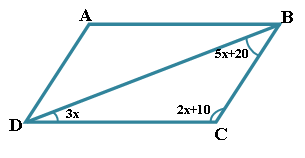 | |
In the following figure, ABDC, ABFE are parallelograms. Which of the following is true about the angles of this parallelogram?
| |||
| Right Option : D | |||
| View Explanation | |||
In the following figure, If ABCD is a parallelogram, then which angles are equal?
| |||
| Right Option : D | |||
| View Explanation | |||
In the following figure, which of the angles will be equal if PQRS is a parallelogram?
| |||
| Right Option : B | |||
| View Explanation | |||
Students / Parents Reviews [10]
Abhyas is a complete education Institute. Here extreme care is taken by teacher with the help of regular exam. Extra classes also conducted by the institute, if the student is weak.

Om Umang
10thMy experience with Abhyas academy is very good. I did not think that my every subject coming here will be so strong. The main thing is that the online tests had made me learn here more things.

Hiya Gupta
8thAbhyas Methodology is very good. It is based on according to student and each child manages accordingly to its properly. Methodology has improved the abilities of students to shine them in future.

Manish Kumar
10thMy experience was very good with Abhyas academy. I am studying here from 6th class and I am satisfied by its results in my life. I improved a lot here ahead of school syllabus.

Ayan Ghosh
8thIt was good as the experience because as we had come here we had been improved in a such envirnment created here.Extra is taught which is beneficial for future.

Eshan Arora
8thMy experience with Abhyas is very good. I have learnt many things here like vedic maths and reasoning also. Teachers here first take our doubts and then there are assignments to verify our weak points.

Shivam Rana
7thA marvelous experience with Abhyas. I am glad to share that my ward has achieved more than enough at the Ambala ABHYAS centre. Years have passed on and more and more he has gained. May the centre flourish and develop day by day by the grace of God.

Archit Segal
7thI have spent a wonderful time in Abhyas academy. It has made my reasoning more apt, English more stronger and Maths an interesting subject for me. It has given me a habbit of self studying

Yatharthi Sharma
10thAbout Abhyas metholodology the teachers are very nice and hardworking toward students.The Centre Head Mrs Anu Sethi is also a brilliant teacher.Abhyas has taught me how to overcome problems and has always taken my doubts and suppoeted me.

Shreya Shrivastava
8thBeing a parent, I saw my daughter improvement in her studies by seeing a good result in all day to day compititive exam TMO, NSO, IEO etc and as well as studies. I have got a fruitful result from my daughter.

